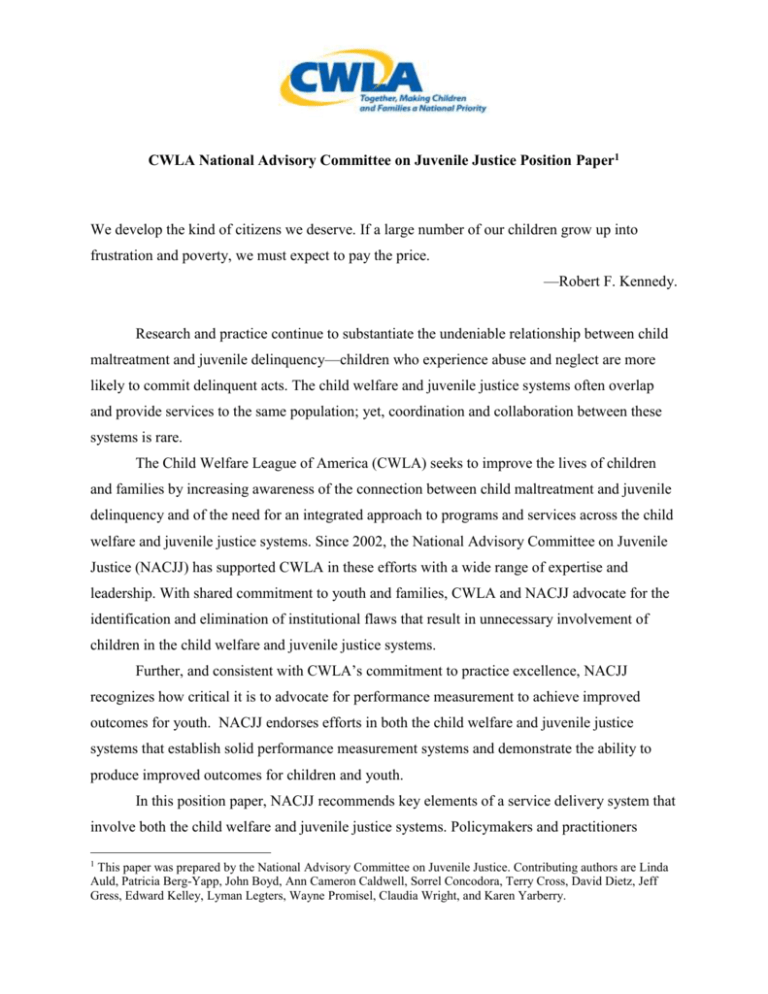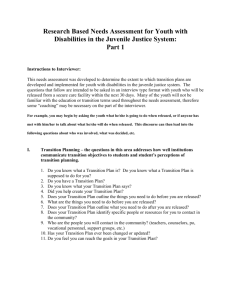NACJJ Position Paper Summary - Child Welfare League of America
advertisement

CWLA National Advisory Committee on Juvenile Justice Position Paper1 We develop the kind of citizens we deserve. If a large number of our children grow up into frustration and poverty, we must expect to pay the price. —Robert F. Kennedy. Research and practice continue to substantiate the undeniable relationship between child maltreatment and juvenile delinquency—children who experience abuse and neglect are more likely to commit delinquent acts. The child welfare and juvenile justice systems often overlap and provide services to the same population; yet, coordination and collaboration between these systems is rare. The Child Welfare League of America (CWLA) seeks to improve the lives of children and families by increasing awareness of the connection between child maltreatment and juvenile delinquency and of the need for an integrated approach to programs and services across the child welfare and juvenile justice systems. Since 2002, the National Advisory Committee on Juvenile Justice (NACJJ) has supported CWLA in these efforts with a wide range of expertise and leadership. With shared commitment to youth and families, CWLA and NACJJ advocate for the identification and elimination of institutional flaws that result in unnecessary involvement of children in the child welfare and juvenile justice systems. Further, and consistent with CWLA’s commitment to practice excellence, NACJJ recognizes how critical it is to advocate for performance measurement to achieve improved outcomes for youth. NACJJ endorses efforts in both the child welfare and juvenile justice systems that establish solid performance measurement systems and demonstrate the ability to produce improved outcomes for children and youth. In this position paper, NACJJ recommends key elements of a service delivery system that involve both the child welfare and juvenile justice systems. Policymakers and practitioners 1 This paper was prepared by the National Advisory Committee on Juvenile Justice. Contributing authors are Linda Auld, Patricia Berg-Yapp, John Boyd, Ann Cameron Caldwell, Sorrel Concodora, Terry Cross, David Dietz, Jeff Gress, Edward Kelley, Lyman Legters, Wayne Promisel, Claudia Wright, and Karen Yarberry. should be challenged to provide for the more effective delivery of services in these key elements (mental health and substance abuse, disabilities, education, disproportionality, gender-responsive programming, and community engagement) and eradicate the barriers that prevent coordination and collaboration between systems. Mental Health and Substance Abuse Concerns about the prevalence of youth mental health needs in the juvenile justice system are escalating. Up to 70% of youth in the juvenile justice system suffer from a mental health disorderi. Many youth in the child welfare and juvenile justice systems experience trauma or traumatic stress and may suffer from anxiety disorders such as posttraumatic stress disorderii. However, improved functioning and reduced recidivism can be achieved with early intervention, a coordinated treatment plan, and ongoing monitoring by professionals. Substance use and abuse is evidenced throughout the juvenile offender population. Youth involved with substances such as drugs and alcohol have an increased likelihood of entering the juvenile justice system; youth who begin substance use at an earlier age are more likely to become severe or chronic offendersiii. In spite of this, substance abuse treatment can reduce offending—particularly if families are included in treatment and interventioniv. Education must be provided to professionals, caregivers, parents, and children about diagnoses, disabilities, medications, and behaviors so knowledge and understanding will inform decisions in these cases. Therefore, we recommend that child welfare, juvenile justice, and mental health systems collaborate to2 provide appropriate and effective services to youth with mental health needs and substance abuse problems; ensure that youth with mental health needs always have access to effective treatment; systematically identify the mental health needs of youth at all critical stages of child welfare and juvenile justice processing; divert youth with identified mental health needs into effective community-based treatment, whenever possible; recognize and include traumatic-stress treatment in service plans, when appropriate; and 2 Mental health recommendations are based largely on “A Blueprint for Change: Improving the System Response to Youth with Mental Health Needs Involved with the Juvenile Justice System” (Skowyra and Cocozza, 2007). 2 include families in intervention and treatment planning for substance abusing youth and youth with mental health needs. Disabilities Another issue of concern is the significant but often-hidden population of youth with disabilities in the child welfare and juvenile justice systems and the inadequate response to their disability-related needs. The Education for All Handicapped Children Act of 1975 (P.L. 94-142) and the Individuals with Disabilities Education Act ([IDEA] P.L. 101-476) identified specific categories of disabilities3 under which children may be eligible for special education and related services. While these federal laws mandate a response within educational settings, disabilities do not begin or end at the classroom door. Often, system-involved youth with disabilities are not recognized as such outside of the classroom. Despite high estimates of the number of youth with disabilities present in these systems, the National Council on Disabilitiesv stated that the American juvenile justice system is ill-equipped to respond to the issues and needs of youth with disabilities in their care because of a lack of awareness, resources, and training on disabilityrelated issuesvi . The child welfare and juvenile justice systems must address and proactively respond to the needs of youth with disabilities. Therefore, we recommend that child welfare and juvenile justice systems collaborate to identify youth with disabilities in the child welfare and juvenile justice systems and provide the appropriate response and support for youth’s individual needs; require all youth- and family-serving agencies to increase awareness and educate employees about youth with disabilities; require additional disability-related training (recognition, response, skills, etc.) for professionals who work directly with youth and families; and ensure all communities are able to provide support, resources, and education to the caregivers of youth with disabilities. Education As defined by IDEA, the term child with a disability means a child “with mental retardation, hearing impairments (including deafness), speech or language impairments, visual impairments (including blindness), serious emotional disturbance, orthopedic impairments, autism, traumatic brain injury, other health impairments, or specific learning disabilities; and who, by reason thereof, needs special education and related services.” 3 3 Quality education is vital for all youth to maximize their potential to become successful members of society as they age into family roles and the workforce and become contributing members of the community. To reduce the number of youth who travel the “school to prison pipeline,” we must properly serve and assist our nation’s children in educational settings. The child welfare and juvenile justice systems need to address the education needs of youth— including those with disabilities—in educational settings. Therefore, we recommend that child welfare, juvenile justice, and education systems collaborate to provide quality education to all youth within child welfare and juvenile justice settings; support educational programs that engage families and communities; develop educational advocacy programs for youth in the child welfare and juvenile justice systems that are designed to maximize the potential for completion of a diploma, GED, and other education milestones; document and analyze the educational outcomes and progress of youth in the child welfare and juvenile justice systems; identify youth with disabilities in the child welfare and juvenile justice systems and provide the appropriate response and support for youth’s individual needs recruit, employ, and retain teachers who are qualified to deliver and understand instruction to meet the complex learning styles of youth in the child welfare and juvenile justice systems; and assess youth for vocational planning and programming to support job skills training, career development, and workforce inclusion as they age out of both child welfare and juvenile justice systems. Disproportionality Minority youth in the United States have increased contact with the juvenile justice system compared to Caucasian youth and, ultimately, are being incarcerated at rates well beyond the percentage of Caucasian youth. Disproportionality is a systemic problem that compounds and escalates as youth progress through the system. From first contact with law enforcement through every stage of the juvenile justice process, minority youth are increasingly likely to be enrolled into more restrictive interventions until they represent a majority of those confined. Federal, state, tribal, and local governments; the juvenile justice system; the community; and other child- 4 and family-serving systems are obligated to ensure that all children, regardless of their cultural, ethnic, or racial identities, receive fair and equitable treatment and services that reflect the cultural strengths of their families. Therefore, we recommend that child welfare and juvenile justice systems, tribes, and other community-based organizations, collaborate to develop community-based interventions to avoid unnecessary formal processing of minority youth; provide culturally specific services and parental involvement programs to support rapid reintegration of minority youth into home communities when appropriate; focus resources on the most vulnerable communities; recognize the roles and responsibilities of Indian Tribes in the administration of child welfare and juvenile justice as sovereign governments and fund them accordingly; increase the cultural competence of all personnel who work with youth by establishing higher standards and training, such as Undoing Racism training; require agencies to address and, if necessary, reduce disproportionality; review the impact of all current policies, programs, and procedures on families and children of color, and ensure that they are racially equitable and meet the needs of each community that receives services from them; include disproportionate minority contact reduction in agency mission and strategic plans; monitor progress in reducing disproportionality and disparity of treatment and outcomes; develop and spread cultural competence and “antiracism” tools to filter emerging policies/laws, child welfare and juvenile justice practices, child welfare related evaluation, and research projects with the intent of mitigating/eradicating the impacts of institutional racism in child serving systems; and advocate for federal policy and legislation that mandates states to analyze the prevalence of disproportionality in the child welfare and juvenile justice systems. Gender-Responsive Programming The juvenile justice system and child welfare system need to provide gender-specific programming for girls. Girls enter the juvenile justice system differently than boys, respond differently to juvenile justice placement and programming, and have different needs upon release. Research has made clear that programs for girls in delinquency systems are more 5 effective and appropriate when they are specifically designed to meet girls’ needs. Such genderspecific programs focus on the unique characteristics of girls. Therefore, we recommend that child welfare and juvenile justice systems collaborate to implement: gender-specific programming for girls within child welfare and juvenile justice systems; gender-specific community-based diversion programs to reduce the number of out-of-home placements gender-specific aftercare programs to support the successful transitions of girls back into their home communities; and programming for girls in residential programs, community-based programs or in aftercare that is trauma informed and includes trauma-specific interventions when appropriate. Community Engagement Services to a child and family should be centered in the community. In addition to nurturing relationships within families, communities that provide effective services and treatment allow children to grow and thrive in positive ways. Systems within the community should strive to keep families intact. When a child must be removed from a family and community, the goal of every assessment or case meeting should be to safely reintegrate the child into the family and community as soon as possible. Therefore, we recommend that child welfare, juvenile justice, and community-based systems collaborate to provide community-based services that support children and families while promoting safety, responsibility, and increasing accountability; support programs that engage family and the community, and encourage youth to become successful members of society; encourage local jurisdictions to refocus on community-based solutions, removing children from their families and communities only when necessary; include schools, social workers, courts, probation, police, and family support agencies in treatment/service plan; encourage states, tribes, and local jurisdictions to make formal, accountable efforts to integrate their systems with community-based resources; encourage jurisdictions to make greater use of community-based approaches and programs, such as Balanced and Restorative Justice; and 6 assure that policy, program development, and service delivery is appropriate for the community and driven by informed community advocacy. Conclusion We believe that this paper calls attention to the fact that child welfare and juvenile justice systems share many of the same challenges and opportunities in providing services to systeminvolved youth. Ample evidence supports the importance of systems collaboration. Children and families involved in the child welfare and juvenile justice systems can easily be overwhelmed and confused by the different array of services and expectations. Also important is the reality that the two systems suffer under the weight of service duplication and lost opportunities to share resources and to create and support best practices designed to improve outcomes for these youth. A well-defined, accessible coordinated service delivery system is in every child and family’s best interests. We hope this paper will serve as a foundation to challenge and allow CWLA to provide continuing and enhanced leadership and resources to jurisdictions and agencies willing to make the commitment to collaborate. 7 References i Skowyra, K., & Cocozza, J. J. (2007). A blueprint for change: Improving the system response to youth with mental health needs involved with the juvenile justice system. Delmar, NY: National Center for Mental Health and Juvenile Justice. ii Child Welfare Committee, National Child Traumatic Stress Network, & National Children’s Alliance. (2008). CAC directors’ guide to mental health services for abused children. Los Angeles: National Center for Child Traumatic Stress. iii Young, D. W., Dembo, R., & Henderson, C. E. (2007). A national survey of substance abuse treatment for juvenile offenders. Journal of Substance Abuse Treatment, 32, 255–266. iv Mulvey, E. P. (2009). Research on pathways to desistance: Research update created for the fourth annual models for change national working conference. Available online at www.modelsforchange.net/publications/239 v National Council on Disability. (2003). Addressing the needs of youth with disabilities in the juvenile justice system: The current status of evidence-based research. Retrieved January 13, 2010, from www.ncd.gov vi Caldwell, A. C. (2007). Attitudes of juvenile justice staff towards intellectual, psychiatric, and physical disabilities. Intellectual and Developmental Disabilities, 45(2), 77–89. 8





